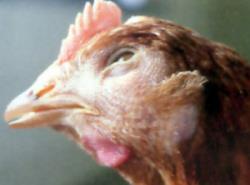 Understandably, the impact of coryza was a major concern at the Winter meeting of American Veterinarians in Egg Production. This ever-expanding group of Veterinarians in North America involved in egg production and breeding convened concurrently with the 2020 IPPE.
Understandably, the impact of coryza was a major concern at the Winter meeting of American Veterinarians in Egg Production. This ever-expanding group of Veterinarians in North America involved in egg production and breeding convened concurrently with the 2020 IPPE.
A case report on coryza in a Midwest complex holding two million hens was presented by the company veterinarian. The condition appeared in two of nine houses on a complex, presenting as mild facial swelling and ascending mortality rising to approximately 0.5 percent per day. A review of house records showed that water consumption fell precipitously three days before onset of clinical signs followed by a drop in feed intake and production and then the appearance of clinical signs and an increase in mortality. The entire flock was treated with CTC at a level of 400 grams per ton.
 Initially there was difficulty in identifying the causal organism Avibacterium paragallinarum. Culture of the organism is difficult using conventional microbiologic culture, but the presence of antigen can be detected using a polymerase chain reaction assay.
Initially there was difficulty in identifying the causal organism Avibacterium paragallinarum. Culture of the organism is difficult using conventional microbiologic culture, but the presence of antigen can be detected using a polymerase chain reaction assay.
The value of the discussion lay in the contribution and collegial interaction among the attendees. A number of older members of the group who have had extensive experience with the control of coryza and specifically Modesto strain C-2 in Californiaand Mexico and various serotypes in South Africa and Asia provided comments.
A participant noted that if tetracycline is administered to flocks the condition can be resolved within three weeks. In the absence of antibiotic therapy, the duration of clinical signs is approximately 21 days. The actual absorption of tetracycline incorporated in a layer diet containing 3.5 to 4.5 percent calcium is questionable. Since there were no untreated controls in the Midwest Complex, it is not possible to comment on the efficacy of medication.
Since Avibacterium is a fragile organism, it does not persist for long in the environment compared with other bacterial pathogens such as Salmonella and Pasteurella. Introduction of an infection onto any farm denotes a deficiency in biosecurity. Failure to subject workers, supervisors and visitors to appropriate de-robing, showering and donning of farm-supplied protective clothing is an obvious risk factor for introduction of coryza. In the context of large complexes, nest-run eggs from contractors introduced into in-line packing plants, contract service crews and modules used for flock depopulation could all be regarded as potential vehicles of infection.
The consensus was that once a complex is infected, the permanent carrier state will require vaccination of replacement pullets either using a commercial multivalent vaccine or if inadequate protection is achieved, an autogenous product is required. Upgrading of biosecurity is critical to preventing exposure.
During the mid-1960’s and 1970’s in some nations where vaccines were unavailable, producers resorted to contrived infection administering Avibacterium (Haemophilus as it was then classified) to six-week old pullets that were then treated with tetracycline. Pullets remained permanent carriers but did not demonstrate clinical signs and their production was unaffected when transferred to a multi-age complex.
Given the recent history of coryza as it emerged in Pennsylvania and extended to Ohio, coupled with the presence of infection in California suggest that the disease will be disseminated to additional regions. More effective vaccines will have to be incorporated into pullet immunization programs once the disease is introduced into a flock.